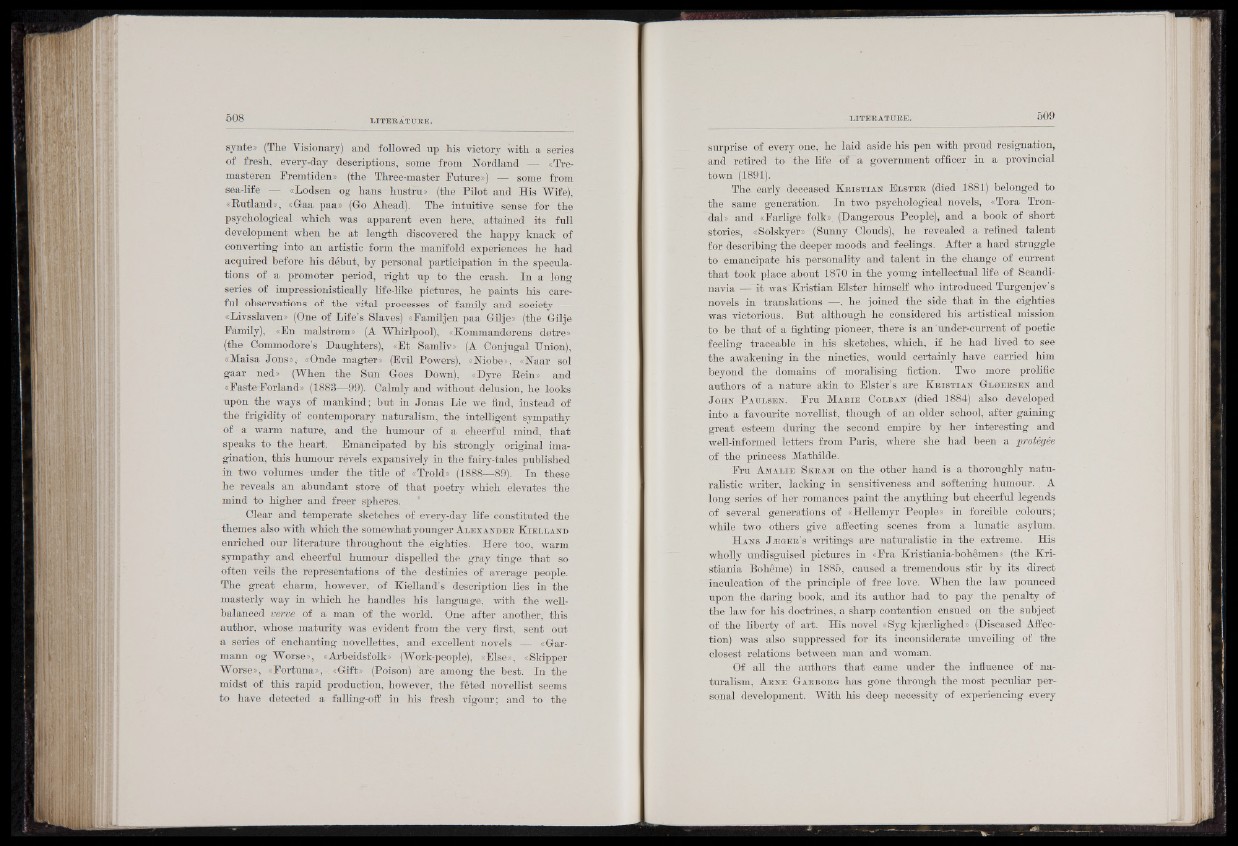
synte» (The Visionary) and followed np his victory with a series
of fresh, every-day descriptions, some from Nordland — «.Tre-
masteren Fremtiden» (the Three-master Futnre») — some from
sea-life — «Lodsen og hans hnstru» (the Pilot and His Wife),
«Rutland», «Gaa paa» (Go Ahead). The intuitive sense for the
psychological which was apparent even here, attained its full
development when he at length discovered the happy knack of
converting into an artistic form the manifold experiences he had
acquired before his début, by personal participation in the speculations
of a promoter period, right up to the crash. In a long
series of impressionistically life-like pictures, he paints his careful
observations of the vital processes of family and society -
«Livsslaven» (One of Life’s Slaves) «Familjen paa Gilje» (the Gilje
Family), «En malstrom» (A Whirlpool), «Kommanderens dotre»
(the Commodore’s Daughters), «Et Samliv» (A Conjugal Union),
«Maisa Jons»,- «Onde magter» (Evil Powers), «Niobe», «Naar sol
gaar ned» (When the Sun Goes Down), : .«Dyre Rein» and
«Faste Forland» ( 188399). Calmly and without delusion, he looks
upon the ways of mankind; but in Jonas Lie we find, instead of
the frigidity of contemporary naturalism, the intelligent sympathy
of a warm nature, and the humour of a cheerful mind, that
speaks to the heart. Emancipated by his strongly original imagination,
this humour révels expansively in the fairy-tales published
in two volumes under the title of «Trold» (1888—=89). In these
he reveals an abundant store of that poetry which elevates the
mind to higher and freer spheres.
Clear and temperate sketches of every-day life constituted the
themes also with which the somewhat younger A l e x a n d e r K i e l l a n d
enriched our literature throughout the eighties. Here too, warm
sympathy and cheerful humour dispelled the gray tinge that so
often veils the representations of the destinies of average people.
The great charm, however, of Kielland’s description lies in the
masterly way in which he handles his language, with the well-
balanced verve of a man of the world. One after another, this
author, whose maturity was evident from the very first, sent out
a series of enchanting novellettes, and excellent novels - - «Gar-
mann og Worse», «Arbeidsfolk» (Work-people), «Else», «Skipper
Worse», « F ortuna »., -, « Gift » (Poison) are among the best. In the
midst of this rapid production, however, the fêted novellist seems
to have detected a falling-off in his fresh vigour; and to the
surprise of every one, he laid aside his pen with proud resignation,
and retired to the life of a government officer in a provincial
town (1891).
The early deceased K r i s t i a n E l s t e r (died 1881) belonged to
the same generation. In two psychological novels, «Tora Tron-
dal» and «Farlige. folk», (Dangerous People), and a book of short
stories, «Solskyer» (Sunny Clouds), he revealed a refined talent
for describing the deeper moods and feelings. After a hard struggle
to emancipate his personality and talent in the change of current
that took place about 1870 in the young intellectual life of Scandinavia
—“it was Kristian Elster himself who introduced Turgenjev’s
novels in translations —:, he joined the side that in the eighties
was victorious. But although he considered his artistical mission
to be that of a fighting pioneer, there is an under-current of poetic
feeling traceable in his sketches, which, if he had lived to see
the awakening in the nineties, would certainly have carried him
beyond the domains of moralising fiction. Two more prolific
authors of a nature akin to Elster’s are K r i s t i a n G l o e r s e n and
J o h n P a u l s e n . Fru M a r i e C o l b a n (died 1884) also developed
into a favourite novellist, though of an older school, after gaining
great esteem during the second empire by her interesting and
well-informed letters from Paris, where she had been a protegee
of the' princess Mathilde.
Fru A m a l i e S k r a m on the other hand is a thoroughly naturalistic
writer, lacking in sensitiveness and softening humour. A
long series of her romances paint the anything but cheerful legends
of several generations of «Hellemyr People» in forcible colours;
while two others give affecting scenes from a lunatic asylum.
H a n s J j s g e r ’s writings are naturalistic in the extreme. His
wholly undisguised pictures in «Fra Kristiania-bohémen» (the Kri-
stiania Bohéme) in 1885, caused a tremendous stir by its direet
inculcation of the principle of free love. When the law pounced
upon the daring book, and its author had to pay the penalty of
the law for his doctrines, a sharp contention ensued on the Subject
of the liberty of art. His novel «Syg kjserlighed» (Diseased Affection)
was also suppressed for its inconsiderate unveiling of the
closest relations between man and woman.
Of all the authors that came under the influence of ■ naturalism,
A r n e G a r b o r g has gone through the most peculiar personal
development. With his deep necessity of experiencing every